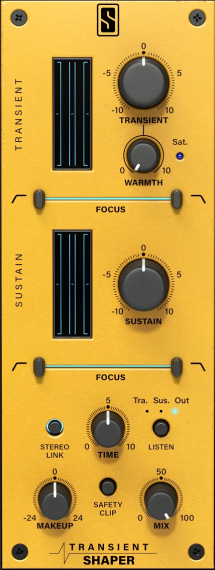Transient Shaper

Have reliable control over the snappiness of your tracks with the most efficient, versatile, and intuitive zero-latency Transient Shaper.
Transient
Adjusts the gain of detected transients. Transient detection is level independent, meaning a threshold is not necessary to adjust the detection and you can change the overall level of the track without affecting its behavior.
Warmth
Adds saturation to the transients. Warmth is independent from the Transient Gain, meaning that you can add bite to transients in the track without having to crank the Transient parameter up.
Focus
Filters the processing signal. Also impacts the sidechain signal used for detection. A band pass behavior is possible by holding SHIFT when dragging one of the faders.
Sustain
Adjusts the gain of detected sustain parts. In a nutshell, this is the tail part of hits.
Time
Adjusts the length of the transient to be processed. It reciprocally affects the sustain.
Listen
Routes a specific signal path to the output: Transient, Sustain or Out, with all the different processes applied to each portion.
Stereo Link
When “On”, a mono signal is used for sidechain detection.
Makeup Gain
Controls the amount of make-up gain applied at the end of the signal path.
Mix
Blends between dry and wet signals.
Safety Clip
Hardly clips the output to 0 dB FS in order to keep a safe gain staging at the expense of a clipping effect.
External Side-Chain
The purpose of the Transient Shaper is to simply separate the transient and sustained portions of the sound from one another and process them separately. When using the External Side-Chain input, this device won’t react to External Side-Chain level changes the way a compressor would; level changes mostly have no impact. However, when you significantly increase the External Side-Chain Gain, the analysis may hear a lot more of the sustained signal over time, thus the sustain level may appear to increase (depending on the nature of the signal used for the External Side-Chain).